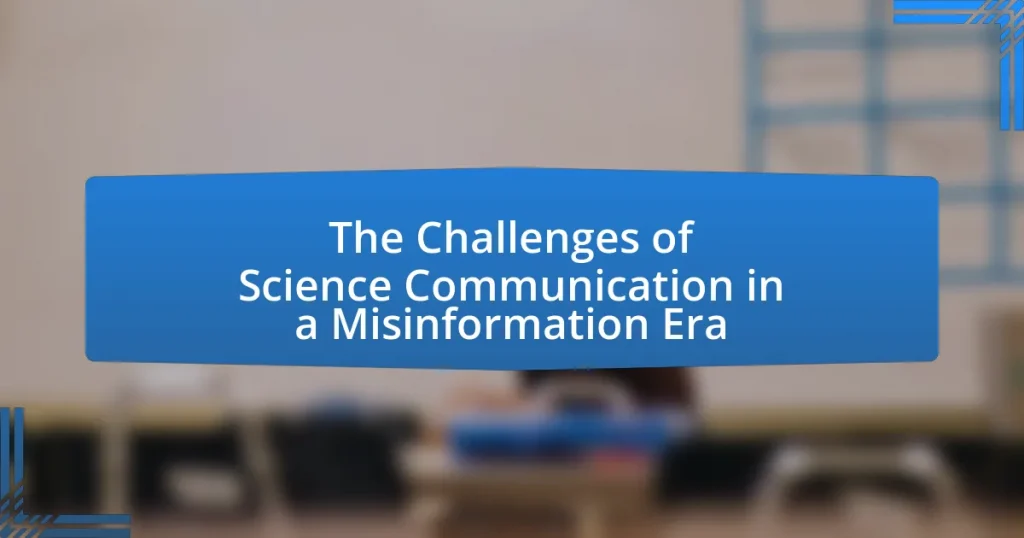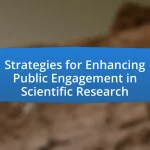The article addresses the challenges of science communication in an era characterized by widespread misinformation. Key issues include the rapid dissemination of false information through social media, the decline of public trust in scientific institutions, and the difficulty of engaging diverse audiences with varying levels of scientific literacy. It explores how misinformation distorts public understanding of science, identifies common sources of misinformation, and discusses the impact of cognitive biases on the reception of scientific information. The article emphasizes the importance of effective communication strategies, the role of scientists in public outreach, and the need for clarity and simplicity in conveying scientific concepts to counter misinformation effectively.
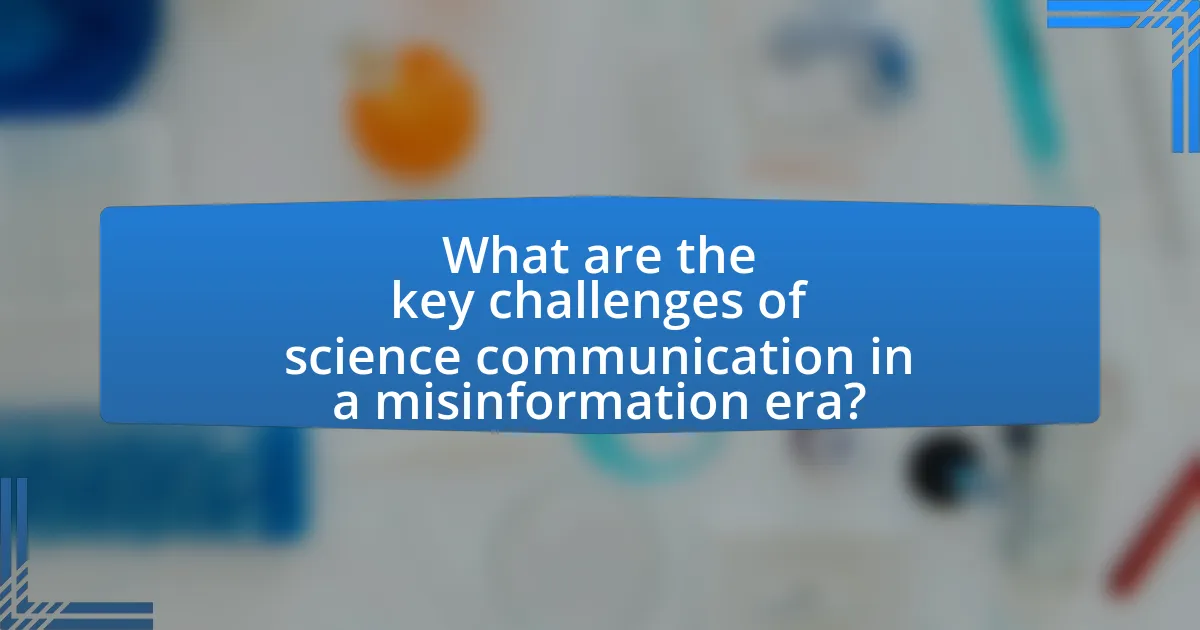
What are the key challenges of science communication in a misinformation era?
The key challenges of science communication in a misinformation era include the rapid spread of false information, the erosion of public trust in scientific institutions, and the difficulty in engaging diverse audiences. The rapid spread of false information is facilitated by social media platforms, where misleading claims can go viral, outpacing accurate scientific information. Research indicates that misinformation can significantly influence public perception and behavior, as seen during the COVID-19 pandemic, where false narratives about the virus and vaccines proliferated. The erosion of public trust in scientific institutions stems from a combination of political polarization and perceived biases in scientific communication, leading to skepticism about expert opinions. Engaging diverse audiences presents a challenge due to varying levels of scientific literacy and differing cultural contexts, which can affect how messages are received and understood. These challenges necessitate innovative strategies in science communication to effectively counter misinformation and rebuild trust.
How does misinformation impact public understanding of science?
Misinformation significantly undermines public understanding of science by distorting facts and creating confusion. When individuals encounter false or misleading information, they may develop misconceptions about scientific concepts, leading to a lack of trust in legitimate scientific findings. Research indicates that exposure to misinformation can result in the rejection of scientifically supported information; for example, a study published in the journal “Nature” found that individuals who were exposed to misinformation about vaccines were less likely to support vaccination, despite evidence supporting its safety and efficacy. This distortion of understanding can hinder informed decision-making and public health initiatives, ultimately affecting societal progress in scientific literacy.
What are the common sources of misinformation in science?
Common sources of misinformation in science include social media, sensationalist journalism, and pseudoscientific publications. Social media platforms often amplify unverified claims, leading to widespread dissemination of false information. Sensationalist journalism tends to prioritize attention-grabbing headlines over factual accuracy, which can distort scientific findings. Pseudoscientific publications may present misleading or fabricated data, undermining legitimate scientific discourse. According to a study published in the journal “Nature,” misinformation spreads faster on social media than factual information, highlighting the significant role these platforms play in the propagation of false scientific claims.
How does misinformation spread in the digital age?
Misinformation spreads in the digital age primarily through social media platforms, where rapid sharing and engagement amplify false narratives. Algorithms on these platforms prioritize sensational content, leading to increased visibility of misleading information. A study by the Massachusetts Institute of Technology found that false news stories are 70% more likely to be retweeted than true stories, highlighting the viral nature of misinformation. Additionally, echo chambers and confirmation bias among users further facilitate the spread, as individuals are more likely to share information that aligns with their pre-existing beliefs.
Why is effective science communication crucial in combating misinformation?
Effective science communication is crucial in combating misinformation because it provides accurate, clear, and accessible information that helps the public understand scientific concepts and data. When science is communicated effectively, it reduces the likelihood of misconceptions and false narratives, which can proliferate in the absence of reliable information. For instance, studies have shown that individuals exposed to well-structured scientific explanations are more likely to trust scientific authorities and make informed decisions, particularly during health crises like the COVID-19 pandemic. This highlights the importance of effective communication strategies in fostering public understanding and resilience against misinformation.
What role do scientists play in public communication?
Scientists play a crucial role in public communication by disseminating accurate information and clarifying complex scientific concepts to the general public. They engage in various forms of outreach, including public lectures, media interviews, and social media platforms, to ensure that scientific knowledge is accessible and understandable. For instance, during the COVID-19 pandemic, scientists provided essential information about the virus, vaccines, and public health measures, helping to combat misinformation and guide public behavior. Their expertise is vital in fostering informed decision-making and promoting scientific literacy among the public.
How can effective communication strategies enhance public trust in science?
Effective communication strategies can enhance public trust in science by promoting transparency, clarity, and engagement. When scientists and communicators present information in an accessible manner, they reduce misunderstandings and misinformation, which are prevalent in today’s information landscape. For instance, studies show that clear messaging about scientific processes and findings can lead to increased public understanding and acceptance of scientific conclusions, as evidenced by the 2020 Pew Research Center report indicating that 86% of Americans believe that scientists should communicate their findings in a way that is understandable to the general public. By fostering open dialogue and addressing public concerns directly, effective communication strategies build credibility and trust, ultimately leading to a more informed and supportive public regarding scientific endeavors.
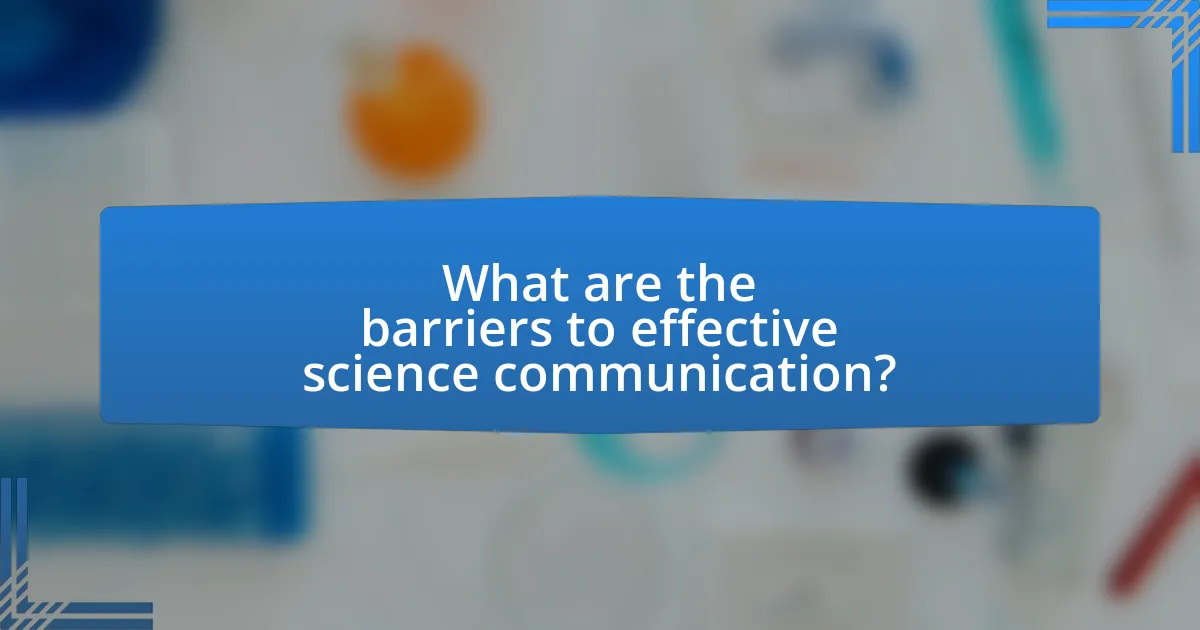
What are the barriers to effective science communication?
Barriers to effective science communication include a lack of understanding of scientific concepts among the general public, misinformation spread through social media, and insufficient training for scientists in communication skills. The general public often struggles to grasp complex scientific ideas, which can lead to misinterpretation and skepticism. Misinformation, particularly on social media platforms, can overshadow accurate scientific information, creating confusion and distrust. Additionally, many scientists receive limited training in how to convey their research to non-expert audiences, which hampers their ability to engage effectively. These factors collectively hinder the dissemination and acceptance of scientific knowledge.
How do cognitive biases affect the reception of scientific information?
Cognitive biases significantly distort the reception of scientific information by influencing how individuals interpret, evaluate, and accept data. For instance, confirmation bias leads people to favor information that aligns with their pre-existing beliefs while dismissing contradictory evidence, which can result in the rejection of scientifically valid findings. Research by Nickerson (1998) highlights that individuals often seek out information that confirms their biases, further entrenching misconceptions. Additionally, the Dunning-Kruger effect causes individuals with limited knowledge to overestimate their understanding, leading to resistance against expert opinions. This phenomenon is documented in studies such as those by Kruger and Dunning (1999), which demonstrate that less informed individuals are less likely to recognize their own lack of knowledge. Consequently, cognitive biases create barriers to effective science communication, making it challenging for accurate scientific information to be received and understood.
What are the most prevalent cognitive biases in science communication?
The most prevalent cognitive biases in science communication include confirmation bias, the Dunning-Kruger effect, and the availability heuristic. Confirmation bias leads individuals to favor information that confirms their pre-existing beliefs, which can distort the interpretation of scientific data. The Dunning-Kruger effect causes individuals with low ability in a domain to overestimate their knowledge, often resulting in the spread of misinformation. The availability heuristic influences people to judge the likelihood of events based on how easily examples come to mind, which can skew public perception of scientific risks. These biases significantly impact how scientific information is received and understood, often exacerbating challenges in effectively communicating science in a misinformation era.
How can understanding cognitive biases improve communication strategies?
Understanding cognitive biases can significantly enhance communication strategies by allowing communicators to tailor their messages in ways that resonate more effectively with their audience. Cognitive biases, such as confirmation bias and the Dunning-Kruger effect, influence how individuals process information and make decisions. By recognizing these biases, communicators can craft messages that anticipate and address potential misunderstandings or resistance, thereby increasing the likelihood of message acceptance. For instance, research indicates that framing information in a way that aligns with the audience’s pre-existing beliefs can lead to greater engagement and retention of the message. This approach is supported by studies in behavioral psychology, which demonstrate that individuals are more likely to accept information that confirms their existing views, thus highlighting the importance of understanding cognitive biases in effective communication.
What challenges do scientists face when communicating with the public?
Scientists face several challenges when communicating with the public, primarily due to misinformation, varying levels of scientific literacy, and emotional responses to scientific topics. Misinformation can spread rapidly through social media, leading to public confusion and distrust in scientific findings. Additionally, the general public often lacks the background knowledge necessary to fully understand complex scientific concepts, which can result in misinterpretation or skepticism. Emotional responses, particularly regarding controversial issues like climate change or vaccines, can further hinder effective communication, as individuals may prioritize their beliefs over scientific evidence. These challenges highlight the need for scientists to develop clear, accessible communication strategies that address public concerns and enhance understanding.
How does the complexity of scientific concepts hinder communication?
The complexity of scientific concepts hinders communication by creating barriers to understanding among diverse audiences. When scientific terminology and intricate theories are used without simplification, individuals lacking a background in science may struggle to grasp the information being conveyed. For instance, a study published in the journal “Public Understanding of Science” by researchers at the University of California found that laypersons often misinterpret scientific data due to the use of jargon and complex explanations, leading to misconceptions and misinformation. This disconnect not only impedes effective dialogue between scientists and the public but also exacerbates the spread of false information, as individuals may rely on simplified or incorrect interpretations of complex scientific ideas.
What are the limitations of traditional media in science communication?
Traditional media faces significant limitations in science communication, primarily due to its inability to provide in-depth analysis and context. This medium often prioritizes sensationalism and brevity over accuracy, leading to oversimplification of complex scientific concepts. For instance, a study by the Pew Research Center found that 62% of Americans believe that news organizations prioritize speed over accuracy, which can result in the dissemination of misleading information. Additionally, traditional media lacks interactivity, preventing audiences from engaging with content or seeking clarification, which is crucial for understanding scientific topics. Furthermore, the reliance on expert opinions can create a barrier, as not all experts are equally represented, potentially skewing public perception of scientific consensus.
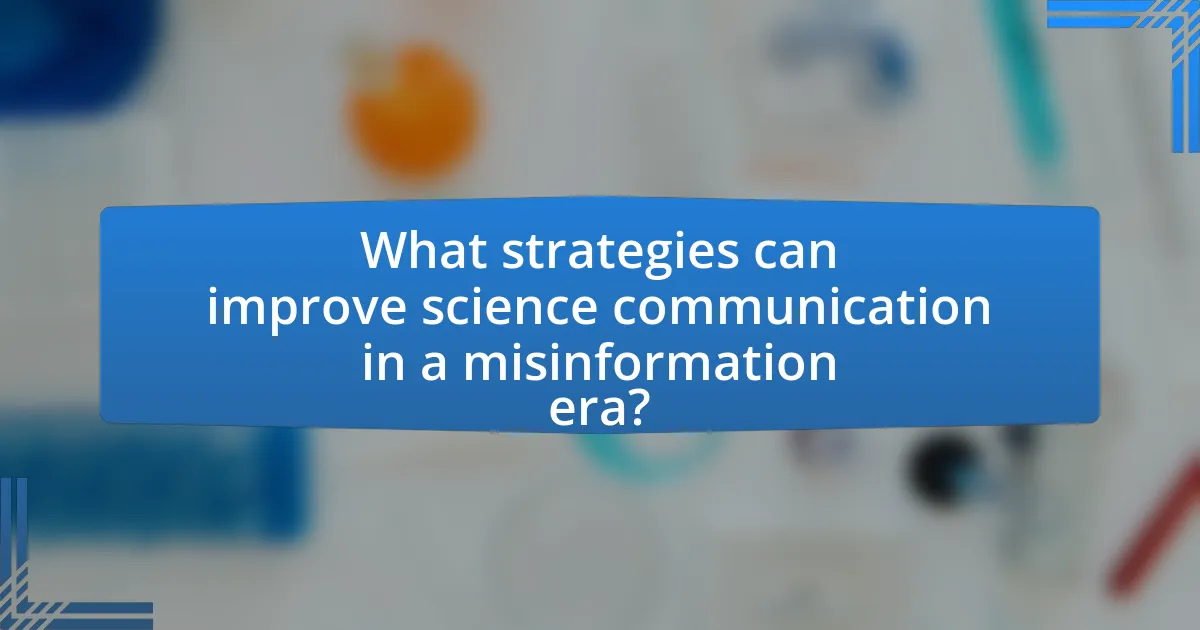
What strategies can improve science communication in a misinformation era?
To improve science communication in a misinformation era, employing clear messaging, engaging storytelling, and leveraging social media platforms is essential. Clear messaging ensures that scientific concepts are conveyed in an understandable manner, reducing the likelihood of misinterpretation. Engaging storytelling can make scientific information more relatable and memorable, which is crucial in capturing public interest. Additionally, utilizing social media platforms allows scientists and communicators to reach wider audiences quickly and effectively, countering misinformation in real-time. Research indicates that effective science communication can enhance public understanding and trust, as demonstrated by studies showing that well-structured communication increases audience retention of scientific facts.
How can scientists effectively engage with the public?
Scientists can effectively engage with the public by utilizing clear communication strategies and interactive platforms. Engaging storytelling, simplified language, and visual aids can help convey complex scientific concepts in an accessible manner. Research indicates that public engagement initiatives, such as community workshops and social media campaigns, significantly enhance understanding and interest in scientific topics. For instance, a study published in the journal “Science Communication” found that interactive science exhibits increased visitor knowledge retention by 30%. By fostering dialogue and addressing public concerns, scientists can build trust and promote informed discussions about science.
What are the best practices for scientists in public outreach?
The best practices for scientists in public outreach include simplifying complex concepts, engaging with diverse audiences, and utilizing multiple communication platforms. Simplifying complex concepts allows scientists to make their research accessible to non-experts, which is crucial in a misinformation era where clarity is essential. Engaging with diverse audiences, including schools, community groups, and online platforms, helps to reach a broader demographic and fosters public interest in science. Utilizing multiple communication platforms, such as social media, podcasts, and public talks, enhances visibility and encourages dialogue. Research indicates that effective science communication can significantly improve public understanding and trust in scientific information, as demonstrated by studies showing increased public engagement when scientists actively participate in outreach efforts.
How can storytelling enhance the impact of scientific communication?
Storytelling enhances the impact of scientific communication by making complex information more relatable and engaging for diverse audiences. When scientific concepts are framed within narratives, they become easier to understand and remember, as stories evoke emotions and create connections. Research indicates that narratives can improve retention of information; for instance, a study published in the journal “Cognitive Science” found that people are more likely to recall facts when they are presented within a story context. This approach not only aids comprehension but also fosters a deeper interest in scientific topics, ultimately countering misinformation by providing clear, compelling, and accurate representations of scientific knowledge.
What role do social media platforms play in science communication?
Social media platforms serve as critical tools for science communication by facilitating the rapid dissemination of scientific information to a broad audience. They enable scientists, institutions, and organizations to share research findings, engage with the public, and counter misinformation effectively. For instance, a study published in the journal “Nature” found that social media can amplify the reach of scientific messages, with platforms like Twitter being used to share research articles and engage in discussions, thereby increasing public awareness and understanding of scientific issues. Additionally, social media allows for real-time interaction, enabling scientists to address questions and concerns from the public, which enhances transparency and trust in scientific communication.
How can scientists leverage social media to counter misinformation?
Scientists can leverage social media to counter misinformation by actively engaging with the public, sharing accurate information, and correcting false claims. By utilizing platforms like Twitter, Facebook, and Instagram, scientists can disseminate research findings, clarify misconceptions, and provide evidence-based responses to popular myths. For instance, during the COVID-19 pandemic, scientists used social media to share data from reputable sources like the World Health Organization, effectively countering misinformation about the virus and vaccines. This proactive approach not only informs the audience but also builds trust and credibility, making it easier for the public to discern reliable information from falsehoods.
What are the risks of using social media for science communication?
The risks of using social media for science communication include the spread of misinformation, oversimplification of complex topics, and the potential for echo chambers. Misinformation can rapidly circulate on social media platforms, leading to public confusion and distrust in scientific consensus, as evidenced by the widespread dissemination of false information during the COVID-19 pandemic. Oversimplification occurs when nuanced scientific concepts are reduced to catchy soundbites, which can mislead audiences about the actual science. Additionally, echo chambers can form when users engage primarily with like-minded individuals, reinforcing existing beliefs and isolating them from accurate scientific information. These risks highlight the challenges faced by scientists and communicators in effectively conveying accurate information in a digital landscape.
What practical tips can enhance science communication efforts?
To enhance science communication efforts, practitioners should prioritize clarity, engage with the audience, and utilize multiple platforms. Clarity involves using simple language and avoiding jargon, which helps ensure that complex scientific concepts are accessible to a broader audience. Engaging with the audience through interactive methods, such as Q&A sessions or social media discussions, fosters a two-way communication channel that can clarify misunderstandings. Utilizing multiple platforms, including podcasts, videos, and social media, allows for reaching diverse demographics and adapting the message to fit different formats. Research indicates that effective science communication can significantly improve public understanding and trust in science, as evidenced by studies showing that clear messaging increases retention and comprehension of scientific information.
How can clarity and simplicity improve public understanding of science?
Clarity and simplicity enhance public understanding of science by making complex concepts accessible and relatable. When scientific information is presented in straightforward language, it reduces cognitive load, allowing individuals to grasp essential ideas without confusion. Research indicates that clear communication can significantly increase retention and comprehension; for instance, studies show that people are more likely to remember information when it is conveyed in simple terms rather than technical jargon. Furthermore, clarity fosters engagement, as audiences are more inclined to participate in discussions about science when they feel they understand the material. This is particularly crucial in a misinformation era, where simplified and clear messaging can counteract false narratives and promote informed decision-making.
What resources are available for scientists to improve their communication skills?
Scientists can improve their communication skills through various resources, including workshops, online courses, and professional organizations. Workshops offered by institutions like the American Association for the Advancement of Science (AAAS) focus on effective science communication techniques. Online platforms such as Coursera and edX provide courses specifically designed for scientists to enhance their public speaking and writing skills. Additionally, organizations like the National Association of Science Writers (NASW) offer resources and networking opportunities that facilitate skill development in science communication. These resources are validated by their widespread use in the scientific community, demonstrating their effectiveness in addressing the challenges of communicating science in an era of misinformation.
